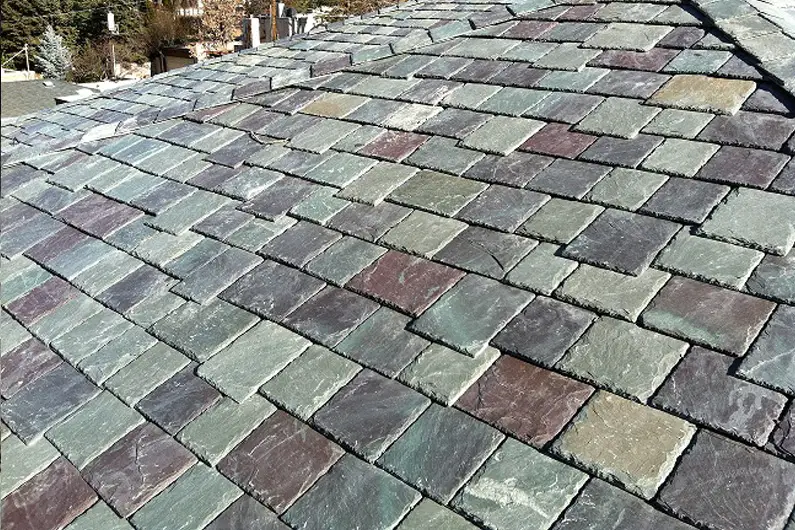Slate Roof Cost Guide (2024) • By Type and Thickness
By Jack Gray, Roof Online Editor • Published March 2, 2024
For more information about slate roofs, please see our introductory article on slate roofing.

Table of Contents
Introduction
We’re professional roof consultants and we spend a lot of time researching roof replacement costs for our clients. This means keeping up-to-date with changing material and labor costs for all kinds of roofing, including slate roofs. We thought publishing and updating our cost estimates online would be a helpful resource for us, our clients, and homeowners in general, so here you go.
Keep in mind that the cost of any particular slate roof will depend on several variables, including roof size, roof pitch, roof complexity, local labor costs, and the quality and thickness of the materials. The estimated prices we provide are averages, and should only be considered ballpark figures that will give you a general idea of the cost of a slate roof.
On average, the cost of a natural slate roof replacement in 2024 ranges from $17.80 per square foot for lower-quality S2-grade 1/4-inch-thick soft slate to $38.48 per square foot for high-quality S1-grade 3/4-inch-thick hard slate.
For an average 1,700-square-foot roof that uses standard 1/4-inch-thick hard natural slate (the most common slate roof), the national average cost of a slate roof is around $41,000.
Types of Slate Roofing
The tables below give typical slate roof prices according to the type of slate used. There are several different types of roofing slates, and the type used will affect the roof’s cost, performance, appearance, and longevity.
Natural Slate Roofs
Natural slate is a metamorphic rock that formed over 500 million years ago. Natural slate is quarried and split, sawn, and finished into the slate tiles used on roofs. As a natural stone, slate makes an excellent roofing material. It is naturally waterproof, impervious to decay, and extremely durable.
Standard slate roof shingles are rectangular and ¼-inch (0.64 cm) thick. Thicker slates up to 1-inch thick (2.54 cm) are available. Standard roof slate widths are 6, 8, 10, and 12 inches; standard lengths go from 12 to 24 inches (in increments of 2).
Slate roofing manufacturers offer slate roof shingles that are graded according to how thick the slates are. As with virtually every other roofing material, the thicker the slate is, the longer the roof will last. Typical roofing slate thickness grades include:
- Standard Grade: Slates are 1/4-inch thick
- Standard Grade Rough Texture: Slates are between 1/4-inch and 3/8-inch thick
- Architectural Grade: Slates are 3/8-inch to 1/2-inch thick
- Heavy Grade: Slates are 1/2-inch to 3/4-inch thick
- Estate Grade: Slates are at least 3/4-inch thick
(Our thanks to Greenstone Slate for this list. Click the link to read more about roof slate thickness grades and weights.)
In addition, ASTM International classifies roofing slate (ASTM C406/C406M-15 Standard Specification for Roofing Slate) into three grades based on physical characteristics which lead to an expected service life for each grade:
- Grade S1 (hard slate) – minimum 75 to 100 years (0.25% water absorption)
- Grade S2 (soft slate) – minimum 40 to 75 years (0.36% water absorption)
- Grade S3 (soft slate) – minimum 20 to 40 years (0.45% water absorption)
Over 90% of slate roofs use Grade S1 hard slate. Longevity is one of the key selling points of slate roofing, so why use anything else? Grade S3 soft slate is pretty much never used for roofing.
Phyllite Roofs
Phyllite is not slate, strictly speaking, but it looks very similar and phyllite roof tiles are manufactured and installed in practically the exact same way as slate. Phyllite is also a metamorphic rock and formed much the same way as slate, but it is older, denser, and harder. Phyllite contains larger and more visible mica flakes than regular slate, which leads to a highly-desirable sheen on phyllite roofs. Material costs for a phyllite roof can be up to twice that of a regular natural slate roof.
Hybrid Slate Roofs
Hybrid slate should be considered a roof system rather than a roofing material. Hybrid slate was developed by roofing manufacturers for customers who wanted a natural slate roof but for whom that was not an option, either because of the cost or because their houses could not structurally support the weight of a regular, traditional slate roof.
Hybrid slate roofs use slates that are only about 40%-45% as long as normal slates, greatly reducing the material cost and weight of the roof. On a hybrid slate roof, only the exposed part of the slate is slate; the part of the slate that would normally be hidden by the overlapping courses above it is replaced by a waterproof membrane. These membranes perform the waterproofing function of the roof, while the slate hides and protects these membrane components.
Hybrid slate roof systems can be expected to last 30 to 50 years.
Synthetic Slate Roofs
First of all, synthetic slate is not slate, although it can look a lot like the real thing, and generally has a very attractive appearance. Synthetic slates and tiles are typically made of molded plastic or rubber, often containing a significant amount of recycled material. In the roofing industry, these products are often referred to as synthetic composite slates, tiles, or shingles.
Artificial slate roofs can typically last 40 to 60 years, which means that this material is far less durable than natural slate. However, a synthetic slate roof is also much lighter in weight and more affordable than natural slate, so it’s something to consider if your budget is limited or your house cannot structurally support the weight of a slate roof.
Things to Keep in Mind
These cost estimates should be fairly accurate; we try to keep them up-to-date using current or recent material prices and labor data.
Keep in mind that the costs listed below are national averages, and costs can vary significantly according to location.
To get a more accurate idea of what a new slate roof will cost in your area, see our article “Relative Construction Costs by U.S State” and apply your state’s multiplier to the national average cost given below.
The slate roof cost estimates we give here are for installation on a roof with a 6/12 pitch or below and include all typical slate roof components. Steeper roofs can cost up to 50% more. Removal of an existing roof may add $1 to $3 per square foot.
Table 1: Slate Roof Cost per Square Foot
| Average Cost of a Slate Roof | |||
|---|---|---|---|
| Type of Roofing Slate | Average Installed Cost Per Square Foot |
Average Installed Cost Per Square (100 sq. ft.) |
Average Installed Cost Average Roof (1700 sq. ft.) |
| Hard Natural Slate (Grade S1) “Standard” 1/4″ Thick |
$24.05 | $2,405 | $40,885 |
| Hard Natural Slate (Grade S1) “Rough Texture” 1/4″ to 3/8″ Thick |
$26.75 | $2,675 | $45,475 |
| Hard Natural Slate (Grade S1) “Architectural” 3/8″ to 1/2″ Thick |
$31.26 | $3,126 | $53,142 |
| Hard Natural Slate (Grade S1) “Heavy” 1/2″ to 3/4″ Thick |
$34.87 | $3,487 | $59,279 |
| Hard Natural Slate (Grade S1) “Estate” 3/4″ Thick Minimum |
$38.48 | $3,848 | $65,416 |
| Soft Natural Slate (Grade S2) “Standard” 1/4″ Thick |
$17.80 | $1,780 | $30,260 |
| Phyllite Roof Tiles 1/4″ Thick |
$34.15 | $3,415 | $58,055 |
| Hybrid Slate System (Short Slates with Membrane) |
$16.00 | $1,600 | $27,200 |
| Synthetic (Imitation) Slate Tiles Composite Plastic/Rubber |
$12.60 | $1,260 | $21,420 |
Table 2: Slate Roof Cost by Roof Size
| Cost of a Slate Roof by Roof Size | |||
|---|---|---|---|
| Roof Area | Average Installed Cost Standard 1/4″ Hard Slate |
Average Installed Cost Standard 1/4″ Soft Slate |
Average Installed Cost Synthetic Slate |
| 750 Square Feet | $18,038 | $13,350 | $9,450 |
| 1000 SF | $24,050 | $17,800 | $12,600 |
| 1250 SF | $30,063 | $22,250 | $15,750 |
| 1500 SF | $36,075 | $26,700 | $18,900 |
| 1750 SF | $42,088 | $31,150 | $22,050 |
| 2000 SF | $48,100 | $35,600 | $25,200 |
| 2250 SF | $54,113 | $40,050 | $28,350 |
| 2500 SF | $60,125 | $44,500 | $31,500 |
| 2750 SF | $66,138 | $48,950 | $34,650 |
| 3000 SF | $72,150 | $53,400 | $37,800 |
| 3250 SF | $78,163 | $57,850 | $40,950 |
| 3500 SF | $84,175 | $62,300 | $44,100 |
| 3750 SF | $90,188 | $66,750 | $47,250 |
| 4000 SF | $96,200 | $71,200 | $50,400 |
More About Slate Roofing
Slate, a natural stone, is a premier choice for roofing due to its beauty, durability, minimal maintenance, and longevity. It’s often seen on historic buildings and is an ideal option for homeowners seeking high-quality roofing.
Pros of Slate Roofing:
- Aesthetically pleasing with a timeless appearance
- Extremely durable, with natural slate roofs lasting over a century
- Safe for the environment and all-natural; it has essentially zero negative environmental impact
- Fire-resistant, with a Class A fire rating
- Impervious to insects and low maintenance requirements
- Old roofing slates can often be reused
- Offers excellent wind resistance
Cons of Slate Roofing:
- High installation and repair costs
- Heavy weight, which might be too much for some structures
- Fragility under foot traffic
- Finding qualified slate roofers can be challenging
What is Slate Roofing?
- Slate is a metamorphic rock formed over 500 million years ago, is waterproof, resistant to decay, and extremely durable.
- Standard slate roof shingles are ¼-inch thick and they can vary in width and length.
- Slate roofing uses copper or stainless steel nails, and accessories like ridge coverings and gutters are typically made from copper or zinc.
Slate Roof Styles:
- Various styles include standard, patterned, random width, multicolored, graduated length, and textural. Each style offers a unique aesthetic.
Sustainability:
- Slate is an environmentally friendly option, requiring minimal energy in production and is often reusable.
Weight and Structure Considerations:
- Standard slate roofing weighs about 10 lbs per square foot, potentially requiring structural reinforcement before installation.
Working on Slate Roofs:
- Specialized tools, expertise, and experience are required.
- It’s advisable to hire highly-qualified, experienced professionals for slate roof installation or repairs.
Finding a Slate Roofing Contractor:
- Essential to choose contractors specializing in slate roofing.
- The Slate Roofing Contractors Association offers resources for finding qualified professionals.
About the Author
Jack Gray is a principal roof consultant and vice president at the Moriarty Corporation, an award-winning building enclosure consultant firm founded in 1967. He is also the editor of the Roof Online website.

Mr. Gray has worked in the roofing industry for over 25 years, with training and practical experience in roof installation, roof inspection, roof safety, roof condition assessment, construction estimating, roof design & specification, quality assurance, roof maintenance & repair, and roof asset management.
He was awarded the Registered Roof Observer (RRO) professional credential in 2009.
He also served as an infantry paratrooper in the 82nd Airborne Division and has a B.A. from Cornell University. Read full bio.
